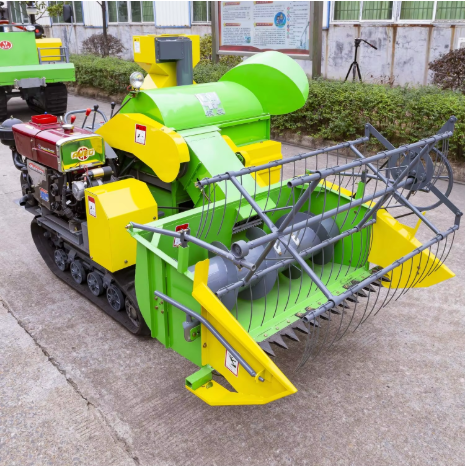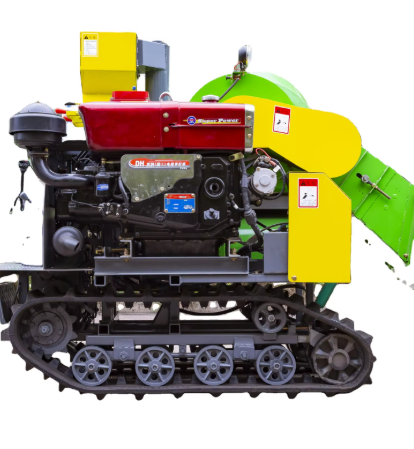What Is a Rice Transplanter? Definition and Purpose
From Manual Labor to Mechanized Efficiency
For generations, rice planting happened entirely by hand, which meant backbreaking work and long days in the waterlogged fields. Farmers would spend weeks bending over in those muddy paddies, carefully placing each seedling where it needed to go. All that depended on having enough workers willing to do the job under tough conditions. Everything changed when mechanical transplanters came along. These machines cut down on how many hands were needed for the job, let planting happen at just the right time, and saved money on wages too. Some studies show that modern equipment can slash labor needs by around 80% compared to old fashioned methods. A recent piece in the Journal of Modern Agriculture points out that farmers who switch to machines often see their bottom lines improve significantly within just a season or two.
Core Function: Transplanting Seedlings into Flooded Fields
Rice transplanters work by moving young plants into waterlogged paddies instead of planting seeds directly. Water filled fields play a big role in growing rice because they keep weeds at bay and provide just the right amount of moisture for those delicate seedlings. The machines do a pretty good job of placing each plant at regular intervals and proper depths even when weather conditions change throughout the season. A recent report from the International Rice Research Institute showed farmers who switched to these transplanters saw healthier crops and better harvests overall, which explains why more growers are making the switch despite initial costs.
Types of Rice Transplanters: Design Variations and Applications
Walk-Behind Transplanters for Small Farms
For small scale farming operations, walk behind transplanters work really well because they're easy to handle and don't cost too much to run. Most models require manual operation so farmers can actually see what's happening during planting. This hands on approach matters a lot when dealing with tricky terrain. Small farms often have oddly shaped plots or areas that bigger equipment just cant reach, making these compact machines absolutely essential in many cases. They fit through narrow paths between rows and around obstacles that would stop conventional machinery dead in its tracks.
- Maneuverability: They can navigate tight spaces and uneven terrains with ease, ensuring effective transplantation even in difficult conditions.
- User-Friendly: Designed for ease of use, they can be operated by individuals with minimal training.
- Cost-Effective: With lower upfront costs and reduced maintenance requirements, they are accessible to small farm owners.
Testimonials from users consistently praise these transplanters for their effectiveness and reliability, enhancing efficiency in various small-holding agricultural environments.
Riding-Type Machines for Large-Scale Operations
Riding-type rice transplanters are designed to meet the needs of large-scale operations, offering high capacity and efficiency. These machines are self-propelled and capable of planting a substantial number of seedlings per hour, drastically improving productivity compared to manual planting methods.
- Advanced Technology: Equipped with technology that allows for faster planting and greater precision in seedling placement.
- Increased Capacity: Can handle large volumes of seedlings swiftly, essential for extensive fields.
- Efficiency: High planting speed allows farmers to cover more area in less time.
Several case studies from large farms demonstrate significant productivity increases thanks to the adoption of riding-type transplanters, which have proven to be a vital asset for maximizing agricultural output.
Automatic GPS-Enabled Transplanters
Automatic GPS-enabled transplanters introduce cutting-edge technology to rice planting, enhancing precision farming through integration with GPS systems. This technology streamlines planting patterns to ensure efficiency and accuracy, minimizing overlap and gaps.
- Precision Planting: GPS technology ensures uniformity in planting patterns, which is crucial for optimal crop health.
- Efficiency Improvement: Reduces human error and maximizes layout efficiency, leading to better use of farmland.
- Yield Enhancement: Research in agricultural settings has demonstrated yield improvements correlated with the precision offered by GPS-enabled systems.
These transplanters represent the future of farming, with studies showing marked increases in yield and consistency across various climatic conditions, showcasing the transformative potential of technology in agriculture.
Seedling Preparation in Mat-Type Nursery Trays
Growing rice seedlings in mat type nursery trays makes all the difference when it comes to getting uniform plants across the field. These special trays help distribute soil and nutrients evenly throughout the tray, so every little plant gets what it needs. Uniform growth means healthier seedlings ready for transplanting, and ultimately better harvests down the road. Seedlings raised this way tend to form much stronger roots, something farmers notice right away once they're planted in paddies. Agricultural specialists point out that proper care during this stage really pays off later on. Regular moisture levels matter a lot, along with feeding them just the right mix of nutrients. Getting these basics right before moving them to the main field sets the foundation for successful rice cultivation season after season.

Pickup Claws and Seedling-Feeding Carousel Mechanism
Pickup claws form a vital part of any rice transplanter setup, their main job being to pull out tender seedlings without causing harm. They team up closely with what's called a seedling feeding carousel, working together so that each plant gets handled properly and doesn't get damaged during transfer. When moving across fields, these little claw mechanisms carefully grab hold of the young plants while at the same time the carousel makes sure everything lines up just right before dropping them into soil. Getting proper spacing between rows and correct planting depth matters a lot for healthy rice growth later on. Farmers often find diagrams really helpful when trying to grasp exactly how all these different parts interact during actual transplanting operations in real world conditions.
Adjustable Row Spacing and Hill Pitch for Optimal Density
The ability to adjust row spacing and hill pitch makes all the difference when it comes to getting just the right plant density in rice fields. Farmers have the option to tweak these settings according to what their crops need and how the environment is behaving at any given time, which lets them create planting plans that actually work for their particular situation. Take for example places where there's lots of moisture in the air - many growers will go with wider spacing between plants to cut down on problems like mold and fungus. But if we're talking about drier areas, tighter spacing often works better because it makes better use of available space without wasting ground. Research from agricultural scientists shows pretty clearly that changing around how dense the plants are grown affects yields quite a bit. That's why having adjustable options matters so much for boosting productivity while keeping those rice plants healthy throughout the growing season.
Key Components of a Rice Transplanter and Their Roles
Drive Wheels and Engine Power System
Drive wheels play a really important role in rice transplanters, making them much easier to move around and operate overall. These wheels help the machine go over various types of ground without getting stuck, which keeps the transplanting process running smoothly. The engine power system inside these machines is closely tied to how well they actually work because it gives the energy needed for all the moving parts. Machines with stronger engines tend to perform better, particularly on bigger farms where speed matters a lot for covering large areas quickly. Farmers looking at different models should pay attention to specs like horsepower when choosing equipment. This tells them what kind of fields the transplanter can handle effectively based on size and terrain conditions.
Seedling Trays and Precision Insertion Mechanisms
Seedling trays make all the difference when it comes to getting plants in the ground right. Farmers rely on them as temporary homes for young plants before moving everything out to fields or gardens. Getting those little guys planted at just the right depth and spaced properly matters a lot for healthy growth later on. Some newer systems now feature special designs that gently guide each seedling into place without bruising delicate roots, something traditional methods often failed at. We've noticed significant upgrades lately thanks to things like sensors and automated guides built into planting equipment. These advancements help ensure every row looks consistent across large farms, ultimately leading to better harvests and fewer losses from weak or damaged starts.
Depth Control for Uniform Planting
The depth control function on rice transplanters makes all the difference when it comes to getting those plants set at just the right level in the soil. When seedlings go into the ground consistently deep enough but not too deep, farmers see much less variation in what grows where across their fields. Studies from places like Japan and India show that rice plants mature better and take up nutrients more efficiently when they're planted at consistent depths. Farmers who have upgraded their transplanters report noticeable improvements in overall field performance. Sure, there are some tricky spots around irrigation channels where things get a bit messier, but generally speaking, good depth control leads to stronger crops and bigger harvests come fall time.
Benefits of Using a Rice Transplanter in Modern Farming
90% Labor Reduction Compared to Manual Planting
Rice transplanters cut down on labor needs quite dramatically, according to research that shows some farms saving around 90% of what they used to spend on hand planting. The impact on farm budgets is huge when workers aren't needed for days at a time, which means lower expenses and better bottom lines overall. Take Indian farms that switched to mechanical transplanting systems recently. These operations saved tons of money on wages and actually produced more rice per acre too. Farmers who adopt this technology don't have to worry so much about finding enough hands during peak seasons anymore. They can spread their limited workforce across other critical tasks without letting rice fields go untended.
High Efficiency: 1 Hectare per Hour Operation
Rice transplanters really boost productivity since they let farmers cover about one hectare every hour, which is way faster than doing it all by hand. With this kind of speed, farmers can actually plan when to plant based on good weather days rather than just working whenever they have free time. Studies comparing different methods show that machines get the job done much quicker than people digging holes and placing seedlings manually. The bottom line is better harvests because crops establish themselves properly, plus money saved in the long run as expenses drop per hectare planted.
Improved Crop Yields Through Consistent Spacing
Rice transplanters help create that just right spacing between plants, something really important if farmers want their fields to produce maximum yields. When plants are spaced consistently, they actually get what they need from nature too – proper sunlight exposure and balanced nutrient uptake throughout the growing season. Agricultural researchers have been pointing this out for years now, showing through field trials that evenly spaced rows tend to give better harvests across different regions. The financial upside becomes clear when looking at those improved yields translating into higher profits for small scale growers especially. While there's definitely value in these machines for contemporary farming methods, many still rely on traditional hand planting techniques due to initial costs and maintenance requirements.
GPS Technology in Rice Transplanters: Enhancing Precision
Mapping Fields for Optimized Planting Patterns
GPS tech is changing how rice gets grown across the country. With it, farmers can map out their fields in great detail, which means they can plan where to plant each row much better than before. When someone actually looks at those maps, they start seeing opportunities to squeeze more plants into available space while keeping everything evenly spaced out. The real kicker though is what happens after planting. These detailed maps help manage resources smarter too. Water gets distributed where it's needed most, fertilizers aren't wasted on areas that don't need them. Most farmers who've adopted this system report bigger harvests from their fields. Some studies back this up showing actual increases in production numbers when compared to traditional methods without GPS guidance.
Real-Time Data Collection for Yield Improvement
GPS tech makes real time data collection possible for farmers, which has become pretty essential for better farming methods and higher yields these days. When farmers collect up to date info about when to plant and manage crops, they get smarter about what needs doing during each stage of growth. The information helps them keep an eye on things and tweak their approach as needed, so fields grow under ideal conditions and crops perform better overall. Studies show farms using this kind of data driven approach tend to see bigger harvests than those relying solely on experience. For many growers, having access to accurate field data gives them an advantage over competitors trying to squeeze every bit of productivity and profit out of their land while keeping costs down.
The Future of Rice Transplanters: Trends and Innovations
Integration of AI for Adaptive Farming
Bringing artificial intelligence into rice transplanters opens up some exciting possibilities for modern farming methods. These smart systems can read what's going on around them - checking out the weather, looking at soil quality, tracking how crops are growing stage by stage. They then tweak the planting process accordingly, almost like having an expert farmer constantly monitoring every square meter of field. Farmers who've tested early versions report noticeable improvements in both yield and resource management. Most experts agree that AI adoption in rice fields is just getting started. While full scale implementation might take time, many believe we'll see significant growth in the next five to ten years as these machines learn from experience and handle more tasks without human intervention.
Sustainable Designs for Eco-Friendly Agriculture
The rice transplanter industry is slowly shifting toward greener designs as farmers become more concerned about their impact on the environment. New materials and smarter engineering are cutting down on both carbon emissions and overall energy needs, which helps make farming practices more environmentally friendly. We're starting to see things like plant-based plastics used in parts that would normally degrade over time, plus smaller engines that run cleaner and last longer between refuels. Research from several universities points to real benefits when switching to these eco-conscious options. Tests show farms using sustainable transplanters produce less harmful gases and actually improve soil quality over time. While going green might cost a bit more upfront, many growers find that their long term savings and better crop performance make it worth the investment. This shift represents an important step forward for agriculture, though there's still work needed to make these solutions accessible to small scale farmers around the world.
FAQ
What is a rice transplanter?
A rice transplanter is a machine designed to automate the transplanting of rice seedlings into flooded fields, facilitating easier farming and improving yield outcomes.
What are the benefits of using a rice transplanter?
Using rice transplanters significantly reduces labor, enhances efficiency by covering more area in less time, and improves crop yields through consistent spacing and precision planting.
How does GPS technology enhance the functionality of rice transplanters?
GPS technology in rice transplanters allows for precise mapping and planting patterns, optimizing resource management and improving yield outcomes through efficient farming practices.
What future technologies could impact rice transplanters?
The future of rice transplanters may include integration of AI and sustainable design innovations, enhancing adaptability and eco-friendliness in agriculture.
Table of Contents
- What Is a Rice Transplanter? Definition and Purpose
- Types of Rice Transplanters: Design Variations and Applications
- Seedling Preparation in Mat-Type Nursery Trays
- Pickup Claws and Seedling-Feeding Carousel Mechanism
- Adjustable Row Spacing and Hill Pitch for Optimal Density
- Key Components of a Rice Transplanter and Their Roles
- Benefits of Using a Rice Transplanter in Modern Farming
- GPS Technology in Rice Transplanters: Enhancing Precision
- The Future of Rice Transplanters: Trends and Innovations
- FAQ

